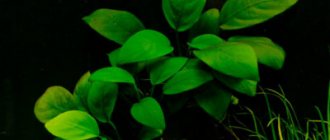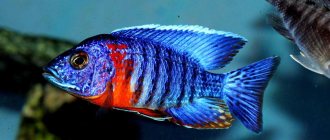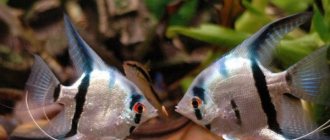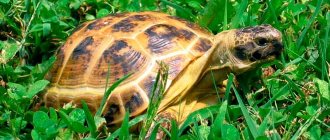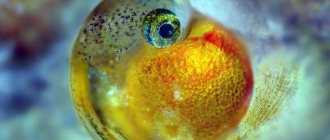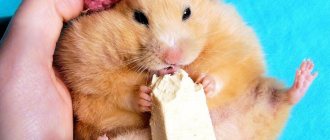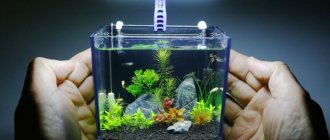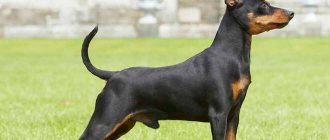This variety requires the hands of an experienced aquarist. For beginners, it’s better to practice on hygrophiles, and then you can move on to anubias. The plant is not cheap and is quite demanding in terms of maintenance conditions. But with proper care, it will become an elegant accent decoration for any herbalist, paludarium or greenhouse.
The genus Anubias has 8 species, some of which are cultivated as aquarium or greenhouse plants. The Barter view is no exception. Named after the Scottish botanist Charles Barter.
Despite the fact that Anubias have been in domestic aquariums for a long time, there is no comprehensive information on their content yet. But the appearance has been studied quite well. These are multi-leafed lush “fountains” spilling out with hard leaves of an expressive green color. Against the backdrop of anemic and pampered aquarium plants, they attract attention with their strong texture and excellent decorative qualities.
There are 7 known varieties of Anibuas Barter, differing from each other in the length, width and shape of the leaf blades.
Morphological characteristics:
- Anubias barteri var. Barteri. It reaches a height of 20 cm, less often 30 cm, a width of 15 cm. Asymmetrical green leaves are collected in a rosette. They have an arrow-shaped shape and a fleshy texture. The leaf blade is 10 cm long, 5 cm wide, and has a characteristic white spot at the base. The main vein is well defined, the side veins are weakly expressed. The rhizome is thick, the appendages are rooted deep into the soil.
- Anubias barteri var. Nana ("Dwarf"). This little one with a shortened stem barely reaches 15 cm in height. The neat, ovoid leaves are dark green. The average length is 5 cm, less often they grow up to 8 cm, width is 3 cm. The rhizome is creeping, branched. There are variations - Wrinkled leaf (“Wrinkled”), Marbled (“Marble”), Yellow heart (“Yellow Heart”), Bonsai (“Bonsai”), Petit (“Small”).
- Anubias barteri var. Glabra (“Naked”. Large representative of the species, up to 30 cm high. There are leaves of both narrow ellipsoidal shape and lanceolate-ovate, up to 12 cm long and up to 6 cm wide. Color - green with pigment spots. Rhizome creeping, laid out along the ground.
- Anubias barteri var. Angustifolia (“Narrow-leaved”). When kept in an aquarium, it grows up to 15 cm, but in a humid greenhouse - up to 40 cm. On a short narrow-leaved stem there are leaves collected in a rosette, up to 15 cm long, up to 5 cm wide. In the upper part, the leaf plates are narrowed, at the base they are wider. The rhizome is creeping, dense, about 2 cm thick.
- Anubias barteri Broad leaf. It is a decorative variety. In comfortable conditions it grows up to 40 cm. Dense and hard leaf plates are found in both heart-shaped and arrow-shaped shapes, up to 18 cm long. The standard height of the bush is 25 cm.
- Anubias barteri var. Caladiifolia ("Coffee leaf"). Another decorative form, characterized by expressive, deeply cut, pointed leaves, up to 22 cm long. The average plant height is 25 cm, the maximum is 60 cm.
- Anubias barteri Variegated (Speckled). This variety is distinguished from other representatives of the Anubias Bartera species by the presence of light bald spots on the leaves. The width of the leaf plate is from 4 to 10 cm, the length is from 8 to 20 cm.
Anubias caféfolia
This is a plant that takes root in the ground. It has a fleshy, thick, periodically creeping, branched rhizome with adventitious cord-like roots. The leaves are asymmetrical, simple, collected in a small rosette. Oval-elliptical leaf blade, leathery, 6 cm wide, 12 cm long, with well-defined lateral and main veins. The leaves are colored rich green, while young ones are reddish-brown. It is worth noting that the petiole is slightly less than or equal to the length of the leaf. The plant reaches a height of 25 cm with a bush width of about 10 cm.
This barter Anubias grows quite slowly. The plant in the aquarium is planted directly on the midline. It adapts perfectly to such conditions. It can be kept in aquaterrariums, paludariums and the coastal zone of artificial pools. Thanks to its tough leaves, this plant is ideal for aquariums containing cichlids.
As already mentioned, Anubias barter requires very simple content. The plant reproduces by dividing the rhizome. It is broken into pieces with three leaves. In this case, leafless areas of the rhizome float further until leaves appear and roots form.
Growing and care
There is an opinion that Anubias are typically terrestrial crops and are not suitable for aquarium keeping. But this statement is controversial. There are not so many 100% aquatic plants, such as hornwort or elodea, in herbalists.
Most representatives of aquaflora, such as Cryptocorynes, Ludwigia or Echinodorus, are amphibians, plants that grow in both aquatic and air environments. Anubias belong to the latter category. Therefore, they can be placed in aquariums, paludariums, and wet greenhouses.
General recommendations:
- All varieties feel more comfortable in tropical aquariums.
- Anubias barteri placement plan. Variegated, Broad leaf - middle or rear, var. nana Wrinkled leaf, var. nana Marbled, Yellow heart - medium, var. nana Bonsai, var. mana Petit - anterior, anterior, Angustifolia, var. Barteri - anterior or middle, Сaladiifolia - middle, anterior, Glabra - posterior.
- Long acclimatization period. Frequent transplantation is not advisable.
- Since representatives of this species have dense and hard leaves, fish are indifferent to them. Therefore, Anubias Barteri can be safely grown in the same aquarium with cichlids.
- The shoots take a very long time to grow.
- It is advisable to plant light-loving crops in the shade, for example, floating on the surface, which can shade Anubias.
- It is preferable to place it in a high tank, since it is easier to organize diffused and overhead lighting suitable for this type.
- In wet greenhouses they demonstrate their best decorative qualities.
- The main pest is blue-green algae.
- The main pathology that aquarists encounter is rotting of the growing point.
Anubias Barter of medium to compact size is planted in groups. Only tall bushes are placed one at a time. This species blooms mainly in the air; in a submerged state it is difficult to achieve the appearance of flower stalks.
Optimal water parameters
Cleanliness is important for Anubias. In conditions of high concentrations of organic matter, the leaf blades become covered with algae, and the plant may die.
Hydrochemical indicators:
- general hardness - 2-15°dH;
- pH - 5.5-8.0;
- temperature - 22-28 °C.
A weekly water change of 25% of the total volume is recommended.
Lighting requirements
- Anubias Bartera is a shade-loving crop. In bright light conditions, deformation of the leaf blade, changes in leaf color to blue-green and the appearance of algae are observed. Lighting - no more than 0.5 W per 1 liter, lasting up to 12 hours.
Soil requirements
- This species has a powerful root system and receives some of its nutrients from the soil. Therefore, the soil must be enriched with nutrients. A good choice of nutritional support is Tetra Complete Substrate.
The need for feeding
If there are living creatures in the aquarium, Anubias does not need to be fed. In all other cases, fertilizers must be applied.
The following drugs are popular among experienced aquarists:
“Florastim” - 1 cube per 30 l.
Tetra PlantaMin - it is advisable to reduce the dosage by 2 times from that indicated in the instructions.
“Kemira Lux” - 0.2 g per 1 liter. An analogue of this drug is “Fertika Lux”.
API Leaf Zone - 5 ml for every 40 l.
If fertilizers are used in dry form, the concentration should be as follows: 0.1% solution. This is 50 ml of solution per 1 liter of water, which is identical to 20 g of powder per 20 liters of water.
Anubias angustifolia
Anubias bartera petit, or narrow-leaved, grows along the banks of swamps, streams and rivers in West Africa: Guinea, Ivory Coast, Liberia, Cameroon.
The stem of this plant is straight and short. Young leaves are collected in a rosette, while adults are broadly lanceolate, alternate, reaching a length of 15 cm and a width of 5 cm. The base of the leaves is narrowed towards the apex, rounded, with a blunt ending. The upper part is slightly wavy, dark green, shiny, and also convex, with a green and matte tint below and a clearly visible main vein. The cuttings are about 15 centimeters long. A creeping rhizome 2 centimeters thick, periodically branched, with light traces of fallen leaves and tuberous thickenings. In an aquarium, the plant reaches a height of 15 cm, 40 cm in a paludarium.
Varieties of Anubias
Anubias afzelii
The rhizome of this species is shortened and develops underground. Because of this, the plant looks more like Cryptocoryne or Echinodorus. The leaves are lanceolate, elongated and pointed. It produces only 1-2 leaves per month. Lighting should not be strong and diffused. In strong light, xenococus, flip flops, or beards appear on the leaves. Loves water changes. The soil should be silted. Suitable water temperature is 25-29 degrees. It is recommended to propagate in a greenhouse. There it grows faster than in an aquarium. When transplanting into an aquarium, Anubias does not require additional preparation.
Anubias Bartera
The most commonly found variety in home aquariums is the Bartera Anubias. The plant is unpretentious to living conditions. There are many varieties of this species found in Africa. Barter's anubias differ from each other in leaf size, shape and even color. There are small plants that grow up to 10-12 cm, and there are giant ones that reach a height of 30 cm. All species grow at a temperature of 24-26 degrees. In this case, the parameters of acidity and water hardness are unimportant. The plant can remain in water for a long time, but sometimes it needs to be transplanted into a humid air environment. Grows in soil, on driftwood and stones. Below we will look at the varieties of Anubias Barter, with a description under each photo.
Anubias Bartera (Anubias barteri var. Barteri) is a large, slow-growing plant, growing up to 30 cm in height. The leaves are 10 cm long and 5 cm wide. The root is powerful. Propagated by dividing the rhizome. It is planted in aquariums with a volume of 100 liters or more. Can be planted in cichlids.
Anubias golden (Anubias barteri var. nana Golden) is a breeding form of Anubias nana. The young leaves of the plant are bright golden in color, but as they grow they become bright green. The size of an adult bush is 10 cm. Planted in the foreground. Responds well to the supply of carbon dioxide and fertilizing. Blooms in good conditions.
Anubias barteri "Glabra" (Anubias barteri var. glabra) grows in central and western Africa along river banks. Grows in and above water. The size of an adult bush is 30 cm. The stem is long and strong. The green leaves are lanceolate-ovate in shape. Their length is 12 cm and width is about 6 cm. The end of the leaf is pointed. Sometimes pigment spots are noticeable on the shoots. Creeping root. The plant produces only 6 leaves per year. Propagated by dividing the rhizome.
Dwarf anubias or Barter's nana anubias (Anubias barteri var. nana) grows in western Africa along river banks and in swamps. The stem of the plant is short, the leaves have petioles and are collected in a rosette. Anubias nana leaves are hard, ovoid, dark green in color, measuring 4-8 cm long and 3-4 cm wide. The rhizome is powerful and creeping. This type of anubis is planted in the foreground, deepening the roots into the soil, and leaving the rhizome on the surface. To create voluminous bushes, they should be planted in groups.
Coffee-leaved Anubias (Anubias barteri var. Coffeefolia) grows in Nigeria, Gabon, Congo. Its leaves are very similar to those of the coffee tree. The rhizome of the plant is creeping. The leaves collected in a rosette are corrugated and asymmetrical. Their shape is oval-elliptical. The leaves are about 12 cm long and about 6 cm wide. Young leaves are red-brown in color and turn green over time. In an aquarium, an adult bush grows up to 15 cm. Requires good filtration and weekly 30% water changes. The soil should be silted. Propagated by dividing the rhizome.
Anubias dwarf "Bonsai" (Anubias barteri var. nana Bonsai) was obtained through selection. The plant is beautiful and unpretentious in maintenance. The leaves are about 2.5 cm long and 1.5 cm wide. The leaves are ovoid in shape and their color is dark green. The root is weak. The size of an adult bush does not exceed 4 cm. Therefore, this species is often planted in nano aquariums in groups of 3 or more bushes. When carbon dioxide and fertilizers are added to the water, it grows faster. It can be planted in the ground without burying the rhizome, and it can also be tied to stones and snags.
Anubias caladiifolia (Anubias barteri var. Caladiifolia) grows in a vertical direction, that is, the leaves are perpendicular to the petiole. The leaf size is 10-20 cm, the shape is oval-elliptical, the end of the leaf is pointed. When the plant reaches the surface, a part of it is cut off and replanted in the aquarium. Australian breeders created Anubias caladifolia with heart-shaped leaves. It's called "1705".
Angustifolia Anubias (Anubias barteri var. Angustifolia) differs from other species in its elongated leaves, 10-15 cm long, collected in a rosette. The upper part of the leaves is wavy dark green with a glossy sheen, the lower part is matte with a green tint. Plant narrow-leaved Anubias in the background or middle ground of the aquarium. Propagated by dividing the rhizome.
Other types
Giant Anubias (Anubias gigantea)
The size of an adult plant is 80-100 cm. At the same time, there are about 30 leaves in the rosette. To grow a giant anubias, you need an aquarium with a volume of 500 liters. It grows slowly, producing only 4 leaves per year. The air form does not tolerate landing in water. When planting anubias, the roots are buried and the rhizome is left on the surface. Does not like the presence of organics and suspended matter in water. In good conditions it can bloom, producing a half-meter peduncle.
Anubias gilletii
Grows in tropical Africa. It grows big there, but much smaller in the aquarium. It does not tolerate prolonged underwater conditions well, losing its beautiful appearance. It is better to keep it in a greenhouse. Grows in the shade. It blooms in good conditions, but the collected seeds are not suitable for growing plants.
Anubias Nangi
This is a selection form obtained by Robert Gasser by crossing the dwarf Anubias Nana with the Gillet Anubias. Very rare in home aquariums. Suitable for small containers. An adult bush grows up to 15 cm. The leaf shape is heart-shaped, the petiole is short, the rhizome is creeping. Propagated by dividing the rhizome. Lands in the foreground.
Anubias graceful (Anubias gracilis)
Rarely found in home aquariums. Prized for its unusual leaf shape. It is triangular-heart-shaped with a wavy surface. It grows very slowly. The surface form must be smoothly transferred to the water form. Loves shade and silty soil. Propagated by dividing the rhizome.
Anubias heterophylla
Grows in the Congo River basin. The leaves are large, up to 40 cm long. Only large aquariums are suitable for its cultivation; it loves warm and acidified water. Periodically, it must be transferred from the aquarium to a humid greenhouse. In this case, only the lower part of the leaf petioles is left under water.
Anubias bartera dwarf, or nana
The homeland of this plant is the tropics of Cameroon. It grows along the banks of streams, swamps, rivers and is almost always located under water, while attaching itself to stones and tree roots. Sometimes it takes root in the ground.
Anubias bartera nana has a shortened stem with a small rosette of petiolate simple leaves. Reaches a height of 12 cm. The leaf blade is oval-shaped, hard, with a sharp tip and a rounded base, dark green with shine, up to 8 cm long, and up to 4 cm wide. The petiole is smaller than the leaf blade, reaches a length of 5 cm. The plant has a branched rhizome, creeping and covered with leaves.
Plant characteristics
This plant is native to West Africa, where it is found in many swampy lakes and rivers. It can grow even on poor soil. Anubias grows slowly, the height of the bush rarely exceeds 20 cm.
The leaves are large and fleshy, distinguished by an elongated shape, reaching about 5 cm in width and 10 cm in length. Their tips are sharp and the base is rounded. Old leaves have white spots. The main veins of the leaves are clearly visible, located asymmetrically on the stem. The stem is shortened, represented by a rosette of cutting leaves.
The rhizome is creeping: a large number of thin shoots extend from 2-3 thick roots. Thanks to this, the root is firmly fixed to the bottom. It may contain tubers in which the plant accumulates nutrients.
Anubias variegated
This is a decorative form of the plant, which is distinguished by the presence of light bald spots on the leaf plates.
The origin of this pattern has no clear interpretation. Some experts consider it to be the product of selective breeding, while others explain this phenomenon by the fact that the plant was infected with a special virus. In any case, this barter Anubias, the photo of which is presented in this article, has a bright personality.
It has a relatively modest size. It is advisable to grow this plant in large aquariums about 50 cm high. In this case, it must be planted in the background or middle ground. The conditions of detention are the same as for other barter Anubias.
Reproduction
As mentioned above, propagation of this species by seeds is in principle possible, but extremely difficult, so vegetative propagation is usually used. During the process of growth, the plant regularly throws out lateral roots, on which buds are formed over time, and then bushy shoots - these are the ones that can be used for propagation.
To do this, they wait until such a bush has formed its own root system, after which it is separated from the mother bush and planted in a new place.
Did you know? In aquariums, not only fish can be predators - aquarium plants can also be carnivores.
For example, Aldrovanda vesiculosa or bladderwrack (Utricularia) are quite capable of capturing and destroying small fish or fry. Aquarists even feed them bloodworms so that the fish do not suffer.
As a rule, all carnivorous plants are rootless and float on the surface - in nature they lived in nutrient-poor environments and thus evolved to predation. As you can see, it is not for nothing that Anubias nana has gained wide popularity among aquarists. This is an attractive and at the same time unpretentious plant, using which you can create a wonderful aquarium landscape. The factors that complicate its maintenance are rare and easily eliminated, so even novice aquarists can easily decorate their underwater landscape with Anubias.
Anubias lanceolata, or lanceolate
This barter Anubias is widespread in the waters of Africa, and also on their coasts. This type of plant can often be found in forest reservoirs of Cameroon, Gabon and Nigeria (southern regions of these countries).
This is a common swamp plant. It can grow in the water column, although its growth will, however, be slow. In the natural environment it reaches 45 cm, but in aquariums it is not found more than 30 cm. The plant has a creeping rather thick rhizome (up to 1.5 cm), in addition, it can be found with thickenings in the form of tubers.
The stem is straight and fairly short. Young leaves are collected in a rosette. Their shape is lanceolate. This plant has a rather interesting color - the full palette of green with its shades is presented from the root to the top (the green is brighter and more saturated at the top).
How it blooms
Flowering Anubias nana is not easy to achieve. Most often, this happens spontaneously, for reasons that are unclear even to experienced aquarium owners: for some it blooms regularly, for others it does not bloom at all, despite varying maintenance conditions.
During the flowering period, which usually begins in spring, the plant throws up a white flower, similar to an ear, wrapped in a green (later lightening) leaf-spread. The flower, which is 4–6 cm long, may reach the surface, or may remain in the water column if the aquarium is too deep.
Important! Pollination of Anubias nana flowers is possible only in the air. In addition, pollination requires the presence of several flowering plants and they will have to be pollinated manually - self-pollination is impossible. So obtaining seeds is a very difficult task, which only specialists can do.
Anubias congo, or variegated
This Anubias bartera grows in the shade of stagnant and slow-flowing water bodies in Africa (Equatorial Guinea, Congo, Cameroon, Gabon, Angola, Zaire). The plant in natural conditions leads a partially underwater life.
Anubias variegata is a slow-growing marsh plant. Its leaf blade is elongated-lanceolate or oval-elliptical in shape, green, leathery, up to 38 cm long, up to 13 cm wide. The tip of the leaf is sharp, the base is short, spear-shaped or arrow-shaped, slightly wavy edges. The lateral and main veins are clearly visible on the leaf plate.
The petiole of the plant is the same as the length of the leaf. Peduncle up to 27 cm long. The covering leaf is about 4.5 cm and opens quite wide when ripe. Small flowers are collected in small cobs, which are clearly visible almost half of the spathe. The seeds are small. The rhizome is fleshy, creeping, thick, periodically branched, with adventitious cord-like roots. The plant is up to 60 cm in height. At the same time, it reaches 25 cm in width.
Structure and appearance of the plant
Anubias nana rarely pleases with flowers, especially in an aquarium.
The size of Anubias is small, the maximum height rarely reaches 10-12 cm. It has characteristic leaves - dense, oval, small, bright green.
In some varieties you can find long and lighter ones, in others - thickened and short, but in the description they are always rounded at the stem and pointed towards the end.
The plant is creeping, covering the bottom of the aquarium, branching its roots. Under favorable conditions, it quickly covers the bottom, growing not only with the root system, but also with leaves. It rarely blooms in water, but in greenhouses it pleases with white flowers . If the inflorescence appears in an aquarium, then after a week it withers and does not produce seeds.
Anubias graceful
This bartera Anubias is native to Sierra Leone and Guinea. It grows in a humid environment, in the shade of trees, along the banks of streams, lakes and rivers that overflow their banks during the rainy season (in this case, the plant remains under water for some time).
It is worth noting that this Anubias has a creeping rhizome about 1.5 centimeters thick. The petiole can reach 60 cm in length and has a short vagina. Leathery leaf blade, arrow-shaped, three-lobed or heart-shaped, up to 40 cm long and up to 20 cm wide, pointed, rounded at the base, green. Pedicel up to 15 cm long. The covering leaf is up to 3 cm long, pointed, oblong-elliptical in shape. The spadix is covered with flowers and is about 3 cm long. Graceful Anubias blooms throughout the spring.
Conditions
In general, this plant is undemanding in terms of maintenance and develops well in various conditions. Anubias nana-petite tolerates both dim and very bright lighting in the range from 0.3 W/l to 1 W/l, preference is given to artificial light. It is best to keep it in a tropical aquarium with a water temperature of 28-30 ° C, but Anubias feels satisfactory in moderately warm aquariums. At water temperatures below 20 °C, the plant stops growing. Water with almost any parameters is suitable, preferably slightly acidic or slightly alkaline. However, it is important to keep the water clean as this plant does not tolerate algae growth on its leaves - weekly water changes are required. For the same reason, prolonged exposure to direct sunlight on Anubias leaves should be avoided.
Anubias giant
This Bartera Anubias is native to Sierra Leone, Guinea, Togo, Cameroon and Liberia. It grows in the shade, in a humid environment, along the banks of lakes, rivers and streams that overflow their banks during the rainy season (in this case, the plant remains under water for quite a long time). Considered one of the largest of its kind. Rarely found in stores.
Anubias giant is a fairly large plant that reaches a height of 1 m. Long and thick petioles grow up to 80 cm. The leaf blade is leathery, green, has various shapes from tripartite to spear-shaped. Its length reaches 30 cm. The plant can simultaneously hold up to 36 leaves. At the same time, the peduncle grows up to 50 cm. The covering leaf is up to 13 cm long, opens wide towards maturity, without bending downwards. The cob is up to 19 cm, almost a third longer than the topmost leaf. Up to 8 stamens. Rhizome up to 3 cm thick, creeping. Giant Anubias blooms all spring.
The plant reproduces by dividing the rhizome. It is broken into small pieces with three leaves. In this case, leafless areas of the root continue to float until leaves and roots appear. Soil with a high organic content is not suitable for young plants, otherwise the root system will develop poorly. Anubias does not like to be replanted frequently.
Anubias barteri var. caladifolia
Known among aquarists as sp. Camerunensis. It has heart-shaped leaves with a deep notch at the petiole.
The width of the leaf blade is maximum at the base, but quickly tapers towards the tip.
Outside of water, the leaves are dark green; under water and at high air humidity they become lighter. In a greenhouse, the leaf size is 15 x 9 cm; when submerged, it is smaller.
Anubias Barthera caladifolia
The leaves of caladifolia have many similarities with the leaves of the terrestrial plant caladium.
Perhaps this is the most beautiful of the “aquatic” Anubias . Being under water for a long time, it practically does not degrade in appearance. If, observing the natural cycle of floods, periodically placing the plant in an air environment, its growth can be accelerated.
In popularity, this subspecies is second only to dwarf anubias . He is also charming, but in a different way. The plant is much larger, with numerous oval-pointed, slightly corrugated leaves, located almost perpendicular to the petiole, 10-20 cm long and 5 to 14 cm wide.
At the base, the leaf blade has a deep heart-shaped cut, so deep that it forms rounded “ears”. True, they are not as pronounced as in hastifolia, but they also attract attention.
It grows well in an aquarium, where it blooms periodically. In an aquatic environment, the rhizome of this anubias does not spread along the bottom, like most other anubias , but tends upward. At its base there are often several daughter bushes, ready, if necessary, to replace the main bush.
When the parent bush reaches the surface, the rhizome along with its daughter plants can be separated and planted in another place. Young plants, having become independent, immediately begin to grow.
The length of the petiole is from one to two times the length of the leaf blade (from 10 to 50 cm). Due to the long petioles, the lower part of the rosette looks bare. Therefore, when decorating aquariums, this Anubias is placed in the background, covering the petioles with other lower-growing vegetation.
In nature, Anubias caladifolia is found in shallow, sometimes swampy water bodies in western Africa.
Tender, light green, young leaves acquire a brownish-olive tint with age, more or less pronounced depending on the conditions.
Anubias caladifolia is a very unpretentious plant and grows well in both hard and soft water with an active reaction close to neutral.
In soft water, with a pH of 6.5-6.7, development occurs somewhat faster. Like other Anubias , it does not like bright light, but can easily withstand shading. The optimal temperature is 22-25°C.
Tough tissues protect Anubias from herbivorous fish. This allows the plant to be used in spacious aquariums inhabited by cichlids and iris.
And finally...
When purchasing Anubias, you need to pay attention to their species. You should not buy plants from trays that contain cold water. Make sure that the anubis does not develop decaying leaves or slimy rhizomes. This may indicate the presence of rhizome rot, as well as vascular bacteriosis in the plant. Patients generally have a putrid characteristic odor. Therefore, be especially careful when choosing algae for your home aquarium. Contact only trusted and reliable sellers.
Description
A mutation that appeared in Singapore as a result of selection. It grows very slowly and can sometimes be extremely difficult to achieve sustainable growth. It looks most decorative when attached to driftwood or stone.
In aquariums it forms squat, dense thickets and is therefore used when planting in the foreground. It looks very decorative when attached to stones and driftwood. Their dark green leaves can decorate any aquarium. Ideal for creating miniature landscapes in small aquariums.
Home care in the aquarium
Not all aquarists allow themselves to grow Anubias in home aquariums. This is due to the rather expensive cost of tropical flora, its slow growth and reproduction. However, it has its advantages: decorativeness and unpretentiousness in cultivation and care.
Let's consider the necessary conditions for growing in an aquarium.
Lighting
Anubias should be protected from bright light.
To do this, it is planted next to taller plants, for example, large echinodorus, nymphea, the shadow of which covers it from light. For many plants, such a neighborhood will be disastrous, but for the shade-loving Anubias, on the contrary, it will benefit.
Due to bright lighting, it becomes covered with algae and this leads to rotting of the leaves.
Nutrient soil
The flora feeds through the root system, so the soil must contain enough organic matter. Frequent application of fertilizers and carbon dioxide is recommended.
However, you should be careful not to harm the fish with an abundance of nitrates.
Temperature
Warm water temperatures, +22°C, +25°C, are suitable for a tropical plant.
When grown in greenhouses, it is permissible to increase it to +30°C for high humidity.
Reproduction methods
- Root division
For this method, you need to pinch off a piece of the root and plant it in nutritious soil.
- Cuttings
The easiest way. In this case, the stem of the plant is broken. After 2-3 weeks, new cuttings will appear at the site of the breakdown. Young cuttings are allowed to grow stronger, and for some time they feed from the mother bush.
The baby, on which more than 5 leaves have already appeared, is separated and planted in the ground. It is better if it is small pebbles, sand and a nutrient substrate, then the roots will easily penetrate the soil.
But soil is not always necessary for this type of crop. Anubias roots can also receive nutrition in water.
To do this, they are attached to a snag so that the plant does not float up and die from the light. You can tie it with fishing line or thread. When the plant takes root and clings to the snag, it is untied.
